Lawyers are the greatest asset of any law firm. Their specialized expertise allows them to diagnose and solve particular legal issues making them technical experts in their field. At the same time, with the rise of globalization, technology, environmental issues and economic instability, clients’ demands become more complex and ambiguous, surpassing traditional law practices, and crossing various jurisdictions. Collaboration becomes a key trend in the legal industry that has traditionally been revolved around individual work. Today we will look in detail at how collaboration in law firms can be promoted and improved with Microsoft Teams.
Collaboration challenges in law firms
Before we get to Microsoft Teams let’s first discuss some of the collaboration challenges that law firms experience.
Autonomous nature of legal professionals
Lawyers’ reluctance to collaborate is deeply rooted in the doctrines adopted by the legal industry throughout its history. Its final goal is achieving the highest revenue, whereas collaboration with other legal service providers is seen as a loss of money. Add competition, monopoly in a particular field of expertise and inward-facing approach to work in the legal world – and you will see why lawyers do not feel encouraged to collaborate. Additionally, most lawyers are simply not used to working in teams and doing so for them can feel daunting.
The modern challenges, however, require deeper involvement of multiple players in resolution of legal problems. Collaboration becomes the key ingredient for success. Those legal organizations who come to realize it soon enough will see most impactful results for their business.
Lack of trust and coordination
Cross-practice collaboration can be challenging due to individual working styles, cultural differences, different expectations and competition. This creates lack of trust and, as a result, the collaboration process becomes difficult to coordinate.
In order to address this issue legal organizations will need to create a working environment that fosters collective work. Adopting digital collaboration tools will greatly facilitate this process. These solutions will allow law firms to create a collaboration structure that enhances communication and teamwork.
Too many channels of communication
Multiple channels of communication is another big issue for law professionals. Not only does it affect productivity by making lawyers juggle between various platforms – email, apps, Skype, and other messengers. It may also pose data security risks as sharing information through unsecured channels can cause accidental information leaks.
To avoid that law farms should deploy a digital collaboration platform that would unify all communication channels. It will allow all the players have secure conversations, meetings and collaboration activities while protecting sensitive data. And this is where Microsoft Teams comes in.
How Microsoft Teams can foster collaboration in the legal industry
Simplify and structure groupwork
Teamwork in law firms or legal departments can by simplified by creating teams for each new legal case in Microsoft Teams. Users can build multiple channels to better structure collaboration workspace and make it easier to store and look for data.
Channels will vary depending on the field of law that your team is practicing and on a particular case. For example, if you’re handling a real estate case, the channels may be:
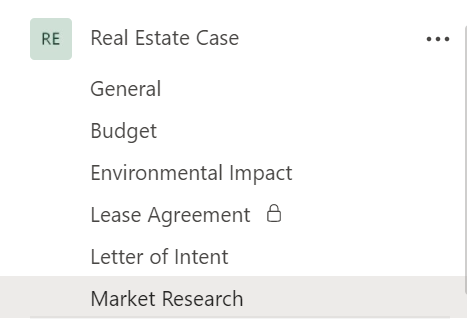
- Letter of intent
- Lease agreement
- Environmental impact
- Budget
- Market research, etc.
You can also create private channels that only limited number of users will see. You can invite external users to private channels – for example, your clients and partners. This way you make sure private information stays secured.
Foster collective decision-making
Microsoft Teams has numerous features that foster collective work. Let’s have a look at some of them.
SharePoint guidelines
In order to help your legal team better coordinate their activities you can create specific guidelines in a SharePoint site. Indicate what channels of communication they can use for specific cases, how they can distribute tasks, outline the rhythm of collaborative work and what Teams capabilities they could use to achieve that. You can explain the purpose of different channels and tabs and set out new norms that the team could follow.
Then you can pin this SharePoint site in tabs in General channel in a relevant team to make sure it’s visible to everyone.
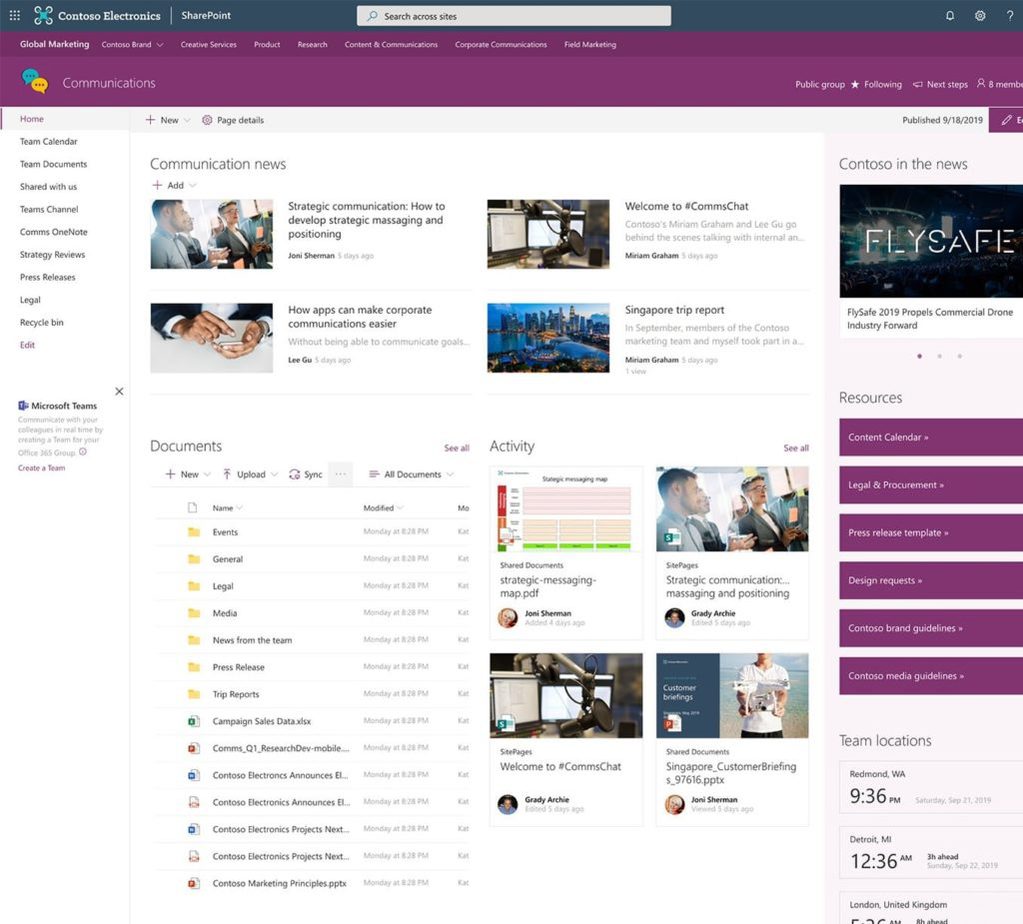
Organize productive meetings
You can have almost real-life meeting experience with Microsoft Teams. Due to its share-screen capability you have the opportunity to present your idea to your team or give a killer sales pitch in front of your computer. Moreover, you can configure custom layouts for a more dynamic content viewing experience.
For a more engaging experience customize how the content is viewed by users. For example, add your own video feed on the foreground of the slides you’re sharing.

Your team can also use Whiteboard app to add ideas and have impactful brainstorming sessions even if you don’t have the opportunity to meet at the office.
The app allows every participant to add notes, type and draw the same way as if you were working with a real whiteboard. Later on. you can share the results with your legal team and continue working on ideas that you agreed on.
Exchange files and share feedback
With Microsoft Teams you can do all your work-related activities in a single workspace. Upload and create all the documentation directly in Teams in relevant channels. Then share them through links with your team members if you’d like them to collaborate or leave comments.

This way you’ll avoid duplication as the document will exist only in one place and all the changes to it will be automatically updated.
Moreover, you can see which changes each user made and reply to their comments.
Manage tasks together
Microsoft Planner is a great tool that will help your legal team coordinate their groupwork, set priorities for tasks and better manage time.
With Planner you can create multiple tasks, divide them into categories and different stages of implementation, add checklists for each task with all the deliverables, attach links and files related to each task, set the timeline and priority level and assign them to any individual in your team.

Then you can track the progress of tasks implementation and decide which tasks should be prioritized according to deadlines.
This is a great way to coordinate activities between experts of different jurisdiction or employees of other departments (finance, business decision makers).
Send emails to team channels
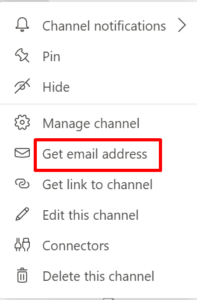
If you want to share an email with your colleagues before sending a reply, you can do that with Microsoft Teams. Each channel has its own email address. You can find it by clicking on More options […]> Get email address.
Forward your email to this address and it will appear in this channel. Your team can discuss its content and make a collective decision.
You can also share your Teams conversation to an email in Outlook, without having to leave Teams.

Integrate all apps into single workspace
If the staff of your law firm use third-party apps in their work, they’d be happy to know that they could be integrated into Microsoft Teams. This will allow them to avoid resorting to multiple channels of communication and perform all the necessary tasks in a single workspace.
Many law firms use CRM tools along with Microsoft Teams, for example Salesforce to manage accounts. Good news is you can interact with salesforce records directly in Microsoft Teams.
You can mention a Salesforce record in Teams channels and conversations, pin it as a tab, view the record pinned on a tab such as Details, Activity Timeline, Related Lists, and Chatter, and edit Salesforce record details.
The same way you can integrate other apps that your organization uses for collaboration and dealing with clients.
These are some of the most common Microsoft Teams use cases. However, the list still goes on.
Now we’d like to demonstrate you how you can further automate the collaboration process with Microsoft Teams Templates.
Microsoft Teams templates for legal teams
Microsoft Teams templates allow users to quickly create rich collaboration spaces with pre-defined channels and pre-installed apps, giving structure and consistency to future teams. It’s a great solution that automates creation of teams and allows to save organizations time and resources.
At the same time, companies that need to improve their collaboration at scale and ensure increased data protection require more advanced solutions that would correspond to both their business and IT needs.
Advanced Microsoft Teams templates by SalesTim further facilitate the process of teams’ creation. They set the right structure for each team with channels, tabs, apps and files, specify a naming convention, and define governance rules and settings.
Today we will take as an example Litigation Case template and describe advanced templates capabilities in action.
Litigation Case template
Having templates for different legal practices and cases such as litigation can help you team get straight to case resolution without spending time on building a new team, adding channels and tabs, uploading standard documents and configuring apps.
Channels
Litigation is a very complex process that requires a lot of research and analysis. Each topic that your legal team will work on in a litigation case can be discussed in separate channels in teams. This will allow to better organize and structure your collaboration.
Even though each case is unique and your teams take different approaches to their resolution, you can build standard channels that would fit any litigation case. For example, include such channels as:
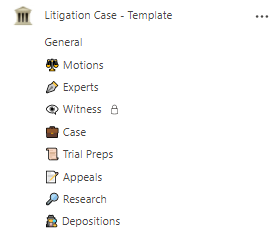
- Case
- Research
- Experts
- Motions
- Depositions
- Witnesses
- Trial preps
- Appeals, etc.
You can also create private channels private and at the template level define Permanent Owners. This means that the individuals that you define as permanent owners will be private channels owners by default.
Later on, after a new team is created from the template, you stuff will be able to modify and add new channels, if needed.
Tabs
With Advanced Microsoft Teams template technology you can upload all the necessary documents into your original team that will be used as a template. These could be legal resources, confidentiality agreements, guidelines, etc. Later on when new teams are creates all the files and folders will be automatically cloned from the template.
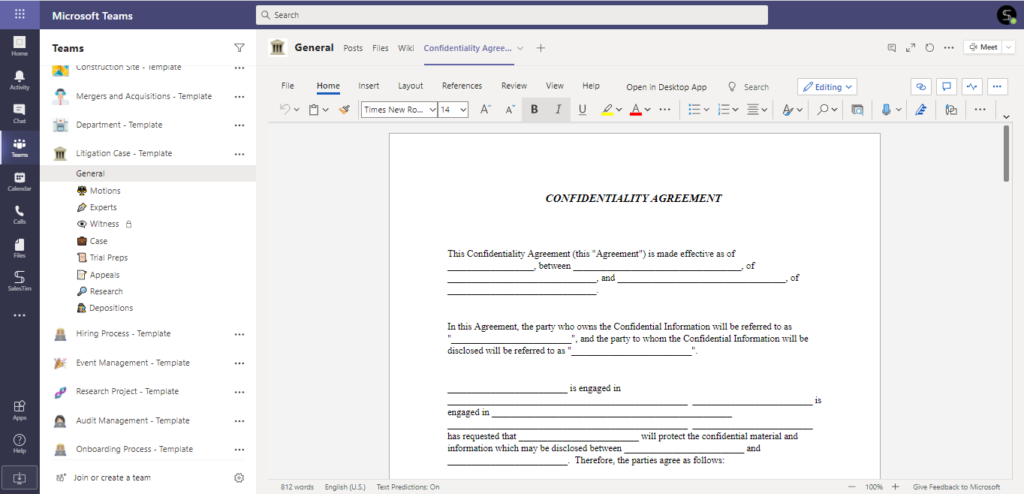
If your legal team performs similar tasks on each litigation tasks, it would be a good idea to pre-build Planner. There you can set up tasks, divide them into categories, add checklists, attach relevant links and documents, select the level of priority and even assign them to the right individuals if you know exactly who members of future teams will be.
If your law firm uses Yammer communities, you can integrate it into your Microsoft Teams template and pin as a tab in the relevant channel. The same goes for any other app that your legal team uses to resolve litigation cases.
After creating the original team with channels, files, apps and tabs, you can start building your template and configure its settings.
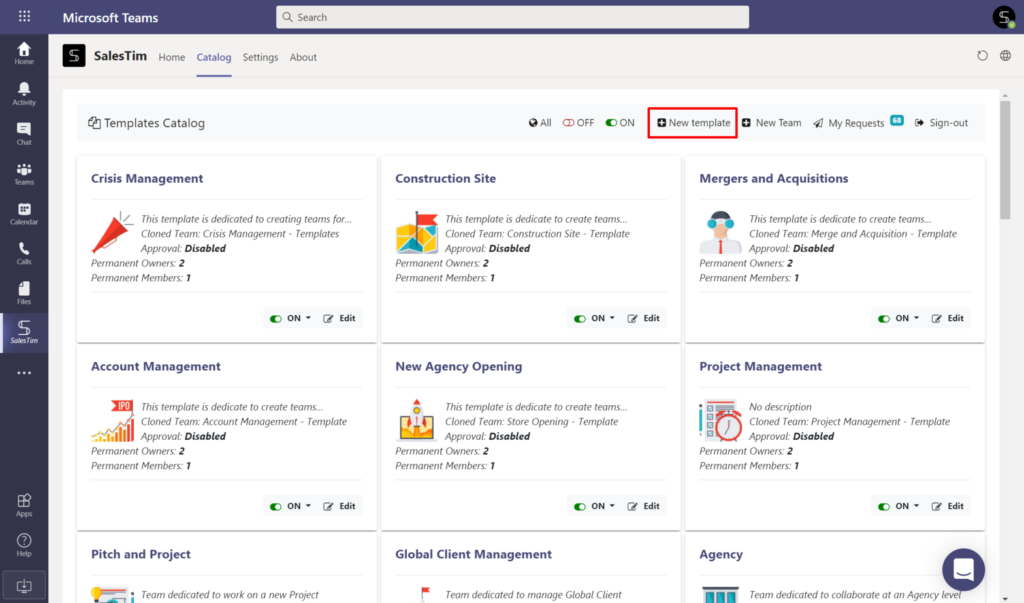
Microsoft Teams and Salesforce integration
Many law firms use Salesforce for document and case management, billing, calendaring and other purposes. With SalesTim, you can manage your entire Teams lifecycle from Salesforce.
You can get automatically provisioned teams for accounts, opportunities and custom object.

Moreover, any update to accounts, opportunities, contacts, or custom objects, could be seen in Teams.
Best of all, people can work on the same documents (with co-authoring), from Teams or Salesforce.

Audience Targeting
When configuring the settings of your template, you can set up Audience Targeting. This will mean that only certain groups of the employees in your firms could see and use the template. For example, you may select your litigation team for audience targeting and other lawyers in your organization won’t have access to it.
After your template is built, your employees will be able to use it to create teams for each new litigation case, and all the data and configurations will be automatically cloned from the template.
There are countless possibilities for Microsoft Teams templates for law firms and in-house legal teams. You can build templates for cases and projects in each legal practice and jurisdiction that your organization offers.
Try for yourself! We can help you build Microsoft Teams templates that will correspond to the needs of your firm and clients.
